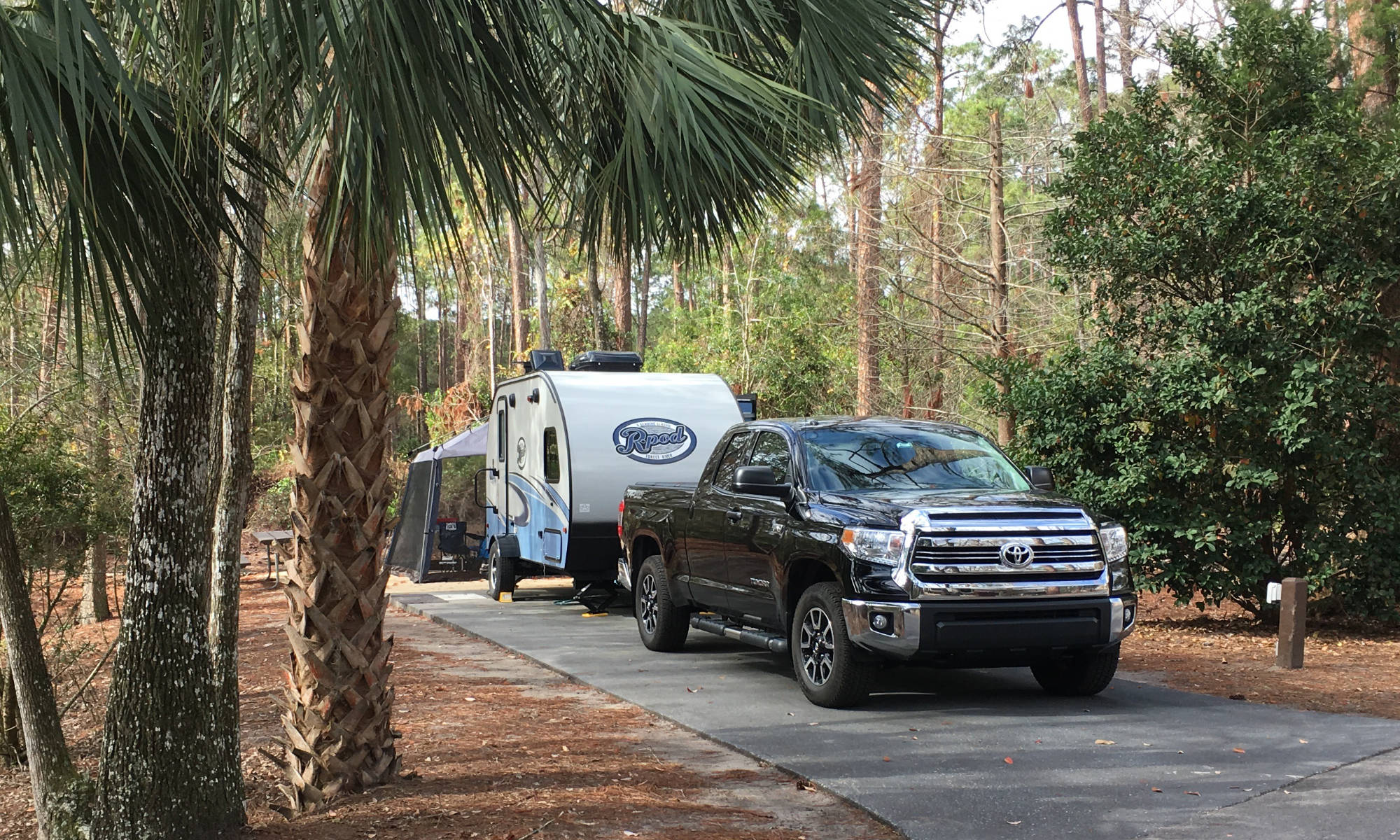In this blog we’ll cover the latest RV and travel data news. September RV wholesale shipment numbers are in, and 5th wheel and travel trailer shipments are down even further than last month. Also, the IndyStar recently published a series of articles exposing the working conditions in many RV factories in the greater Elkhart, Indiana area.
This Month’s Big Story
As reported last month, August 2022 was one of the worst months for RV shipments in six years. September 2022 shipments make August look good in comparison and show that the downturn is severe and ongoing. With a rise in interest rates and the apparent pandemic fast-forwarding of sales, the low and middle market for new RVs has declined significantly. Since most middle-market purchasers use some type of lending product, higher interest rates mean higher monthly payments, effectively pricing a large swath of customers out of the market.
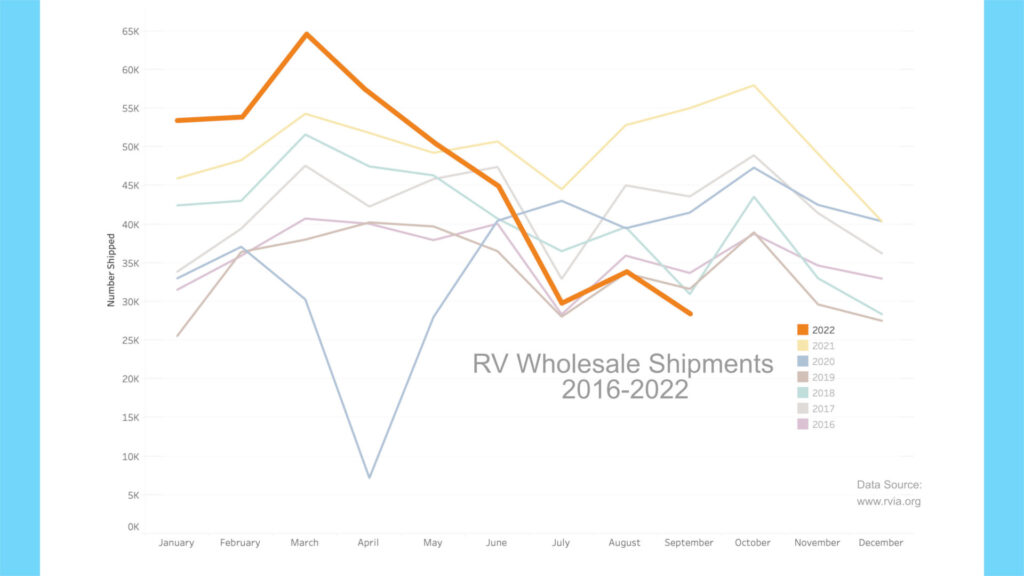
Moreover, we are starting to see indicators that the higher-end RV market is being affected, which we’ll get to in a moment.
The only bright spot in the September shipment report is for Class A motorhomes, Class B camper vans, and Class C motorhomes, which all witnessed upticks in shipments as shortages in motor vehicle production are being worked out. While generally more expensive than travel trailers, volumes are much smaller, making only a slightly positive impact on an otherwise abysmal report.

Production Numbers
On October 25th, the RVIA posted the latest RV shipment data for September 2022, and as just mentioned, the numbers are not at all good. The middle market for travel trailers continues to collapse, given rising interest rates and inflation. Only 28,333 total RVs were shipped in September, compared to the record 55,014 of September 2021, down 48% year-over-year. Travel trailers witnessed the most significant decline, with only 17,599 shipped in September vs. 40,254 a year ago, a 56 percent decline. It was by far the worst September for towable trailer shipments in over six years.

RV Trader
Meanwhile, new and used RVs for sale on RVTrader.com remain stubbornly high, as expected, given that new units are not moving off dealer lots. There were 153,993 new units for sale as of October 26th. This is down slightly from the 156,776 units a month ago, which is very high for this time of year. While new units for sale are staying high, used units are down very slightly from last month, at 52,218. This is now the eighth month in a row with used for-sale units at greater than 50,000. This time last year, the number of used RVs for sale was roughly 46,000.
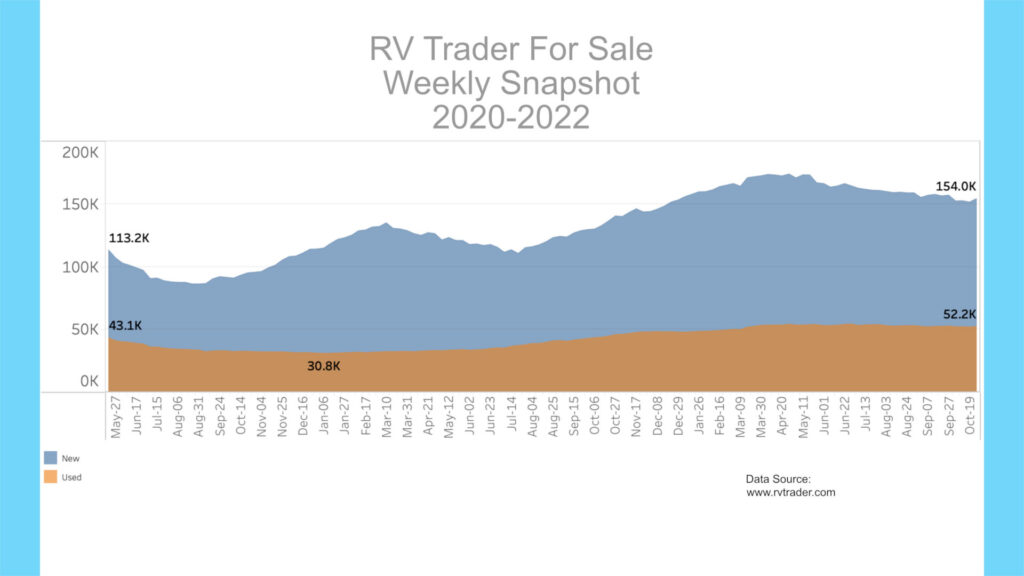
RV Quality Concerns
Meanwhile, manufacturing employment levels in Elkhart County, Indiana, have started to pull back with the decreased shipment numbers. There were 76,400 people employed in manufacturing in September, according to the Bureau of Labor Statistics. This is down from 77,400 in August 2022 and a record 79,200 in June 2022, giving Elkhart an unemployment rate of 2.0% for September. As we’ll discuss in more detail shortly, quality concerns for RVs are justified, given the recent IndyStar series of articles documenting working conditions at various RV manufacturing plants in the greater Elkhart, Indiana area.

High-End Market
Before we go there, let’s look at how the high-end market for RVs is doing. For over a year, we have taken a weekly snapshot of inventory levels at Colonial Airstream in Millstone Township, New Jersey. They are one of the largest Airstream dealers nationwide, so tracking inventory can give us insight into where the high-end market is heading. By the way, we keep all these data on johnmarucci.com in the Resources area if you are interested in diving deeper.

In the past few months, preordered inventory has plummeted and is now less than available inbound units. High-end customers are no longer preordering Airstreams at nearly the same level as even a few months ago. Until recently, 60%+ of Colonial’s inventory was preorders; this is now down to around 40%. Also, more units are now showing up on the lot available for sale. In prior months, only two or three units were on the lot available for sale; now, the number is relatively substantial. All this is to say that the same factors influencing the low and middle markets are now beginning to affect those with more resources. Besides inflation and interest rates, I would add the element of a sharp decline in the stock market, likely influencing the more affluent in purchasing decisions.

Why do these data matter? It matters if you are looking to buy a new or used RV or are planning to sell your RV anytime soon. While costs for RVs have risen with inflation, the pendulum seems to be swinging back toward a buyer’s market for new and used RVs at a fairly rapid pace. Also, there are remaining quality concerns, given the ultra-low unemployment rate in Elkhart, Indiana.
AAA
According to AAA, gas prices have begun to fall slightly over the past week or two yet remain higher than a month ago. The current average nationwide price as of October 26th was $3.764 per gallon for regular unleaded, up about $.04 from a month ago and up about $.38 cents per gallon from a year ago. An RV trip of 3,000 miles at 10 mpg would cost $1,129 now vs. $1,017 a year ago, about an 11% increase. Diesel sits at $5.316 today up about $.42 from month ago and up about $1.71 from a year ago. A similar 3,000-mile trip getting 15 mpg would cost $1,063 now vs. $722 a year ago, a 47% increase.

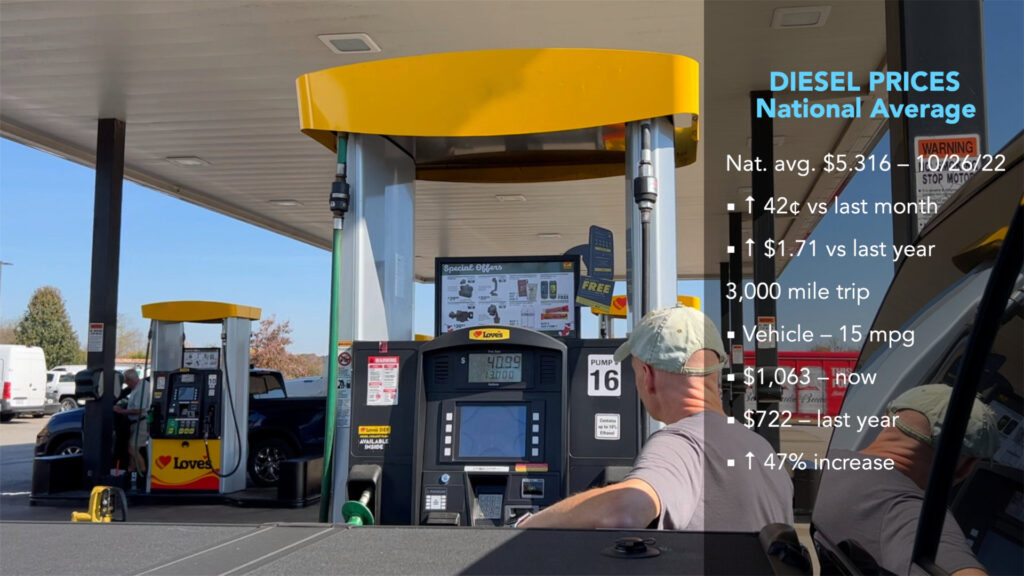
IndyStar Expose’
In mid-October, the IndyStar published a series of articles[1] about the RV industry in Elkhart, Indiana, including working conditions at RV factories and RV quality issues. Around 80% of all RVs produced come out of this area of the country.
In the article about working conditions, the reporter followed the story several workers in RV plants in the Elkhart area. The pandemic was a huge boon to the RV industry, and likely fast-forwarded the production and purchase of hundreds of thousands of RVs. The report states, “Lockdowns that confined Americans to their homes in 2020 created a record demand for recreational vehicles. At the same time, the RV industry successfully lobbied Gov. Eric Holcomb to keep factories open as ‘essential’ businesses even as COVID-19 drove Elkhart County hospitals past capacity.”
It seems that the incredible lobbying power of the multi-billion dollar RV industry facilitated increased production even though workers had serious health concerns. “Worried about outbreaks, workers turned to the Indiana Occupational Safety and Health Administration and asked the agency to inspect factories for safety problems. The RV and related industries in the region were the subject of at least 252 COVID-19 complaints to IOSHA since 2020.
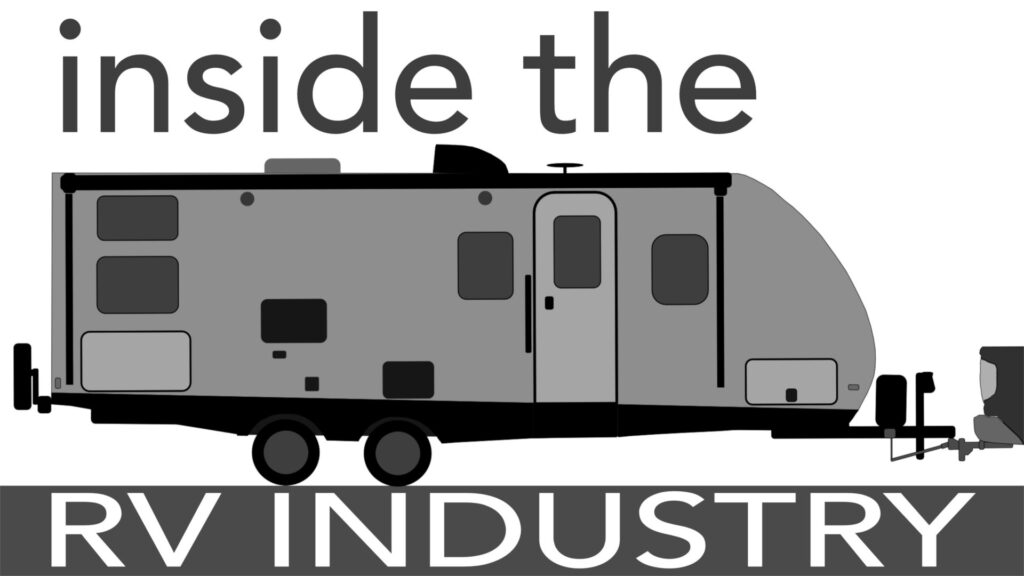
But the state agency responsible for worker safety rarely opened inspections to root out problems. An IndyStar investigation found that was IOSHA’s common practice with COVID-19 complaints across most other industries.
Only two COVID-19 complaints from Elkhart County even led to inspections, according to federal complaint data. And neither involved major RV makers, including the two industry leaders and their subsidiaries that were the subject of a total of nearly 90 complaints. Both inspections led to fines for lack of a respiratory program protecting employees from diseases and toxins in the air, like coronavirus, and other violations.”
Ironically, the RVIA, which argues on its website that RVs should not be seen as essential from a Lemon Law and consumer protection perspective, claimed during the pandemic that RVs were essential to keep factories open. “The RV Industry Association, a trade group that represents RV companies, defended the companies’ response to the pandemic and criticism of keeping the factories open. The industry sought the ‘essential’ designation because Americans living in RVs full time needed repair and maintenance services, RVIA said in a statement.”
As noted in past analyses, the industry pays on a piece work model, which “…incentivize people to work as fast as possible, which workers told IndyStar can lead to quality issues and create injury risks.”
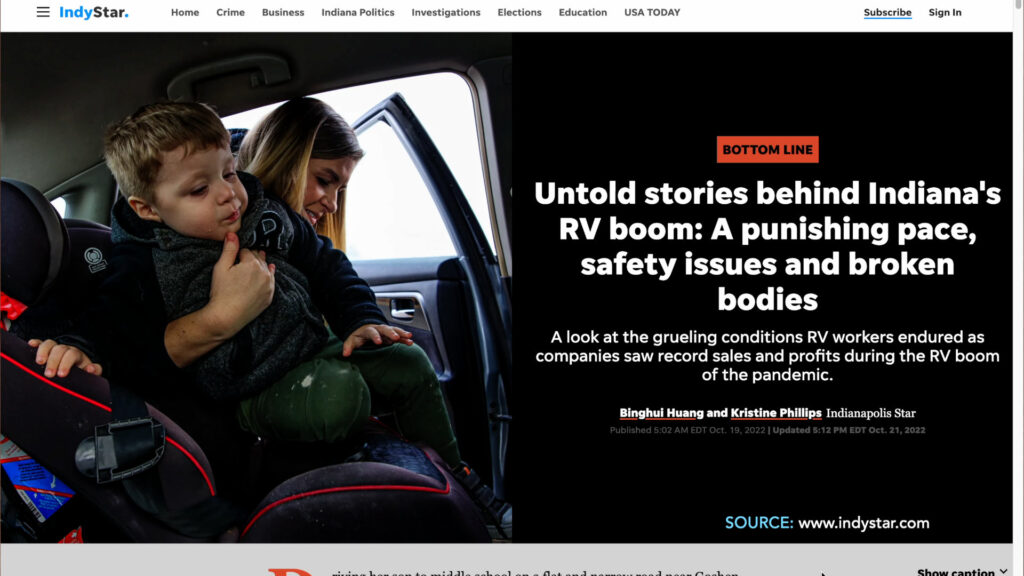
Workers said that conditions deteriorated during the pandemic. “The pace grew more intense as the demand for RVs exploded. The work became riskier. Over the years, he noticed the production lines moved faster as demand rose — and even more so during the pandemic. At Grand Design, owned by RV giant Winnebago Industries, McAfee said he went from making 16 to 36 RVs a day during the pandemic.”
RV Quality
Besides working conditions, several workers and owners spoke about quality problems. One owner, John Kucharski, told the IndyStar, “Issues have become so common that [he] dubbed the units ‘COVID trailers.’ If they’re built in the last two years, expect a lot of problems.”
According to lawyer Ron Burdge, “when they came out of that recession back in ‘08, quite frankly, my experience has been that they decided that, ‘Hey, we can sell these things with less quality and make just as much money. So why should we go back to building better quality?’” he said. “And they just kept doing it. And it’s only gotten worse over the years since then.”
A long-time worker in the RV industry told the IndyStar that “he spent years building RVs,” and “…would never buy one for himself. I would never ever — ever,” he said. “I would never recommend a single one to anyone because I know how they’re built.”
The article also noted the familiar experience of so many new RV owners. An expensive new RV is purchased and almost immediately has serious issues that need warranty work.
“What happens — from factory floors to dealerships to repair shops — is a long and ‘vicious cycle’ that leaves customers ‘frustrated and fed up,’ said longtime RV owner Robert Simmons. When owners call dealerships about the problems, they say, they’re told to call the manufacturers because the issues are covered by warranty. Some say they’re told to call the parts suppliers. No matter where they turn for help, the wait is often several months.”
I can personally testify to this happening to me earlier this year when I purchased an Ember Overland RV. On the night I brought the trailer home, it had a serious leak issue that prevented me from being able to use the trailer. Over the first 90 days of ownership, the expensive trailer was back to the factory four times for warranty work. After getting everything fixed by the factory, I sold the Ember in late summer at a substantial loss. There was a lot of personal stress in my recent ownership experience, which was alleviated once the trailer was sold.
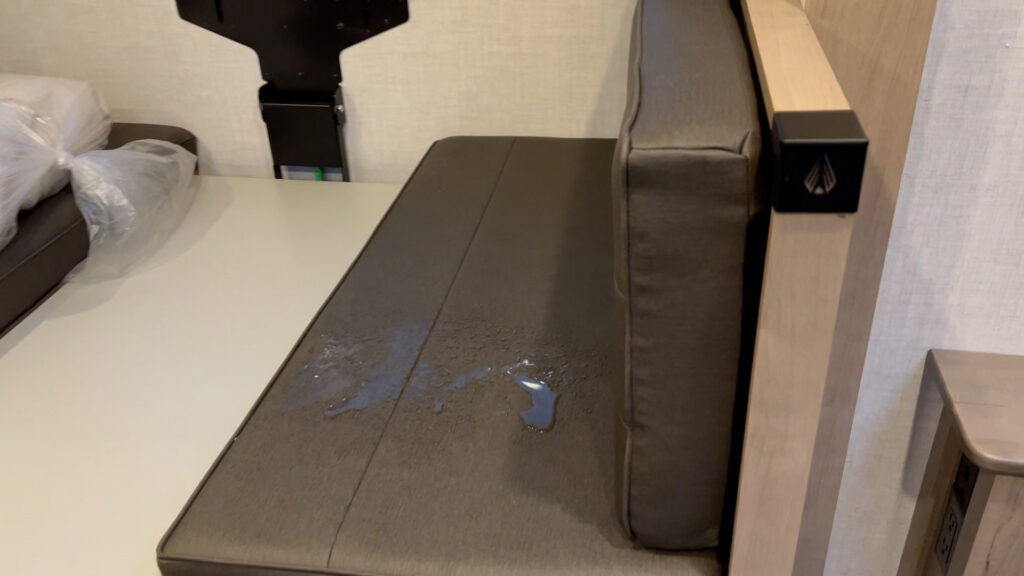
If you are considering a new RV, you may want to avoid RVs built during the pandemic ramp-up. However, production is down in the past two months, which means average line tenure (experience level) should be up, production lines are likely moving slower, and better quality should be an outcome. So, if you are shopping a dealer lot, look at the production sticker on the RV for the manufacture date before taking the plunge. You can also employ a certified RV inspector to go over any RV prior to purchase for peace of mind.[2]
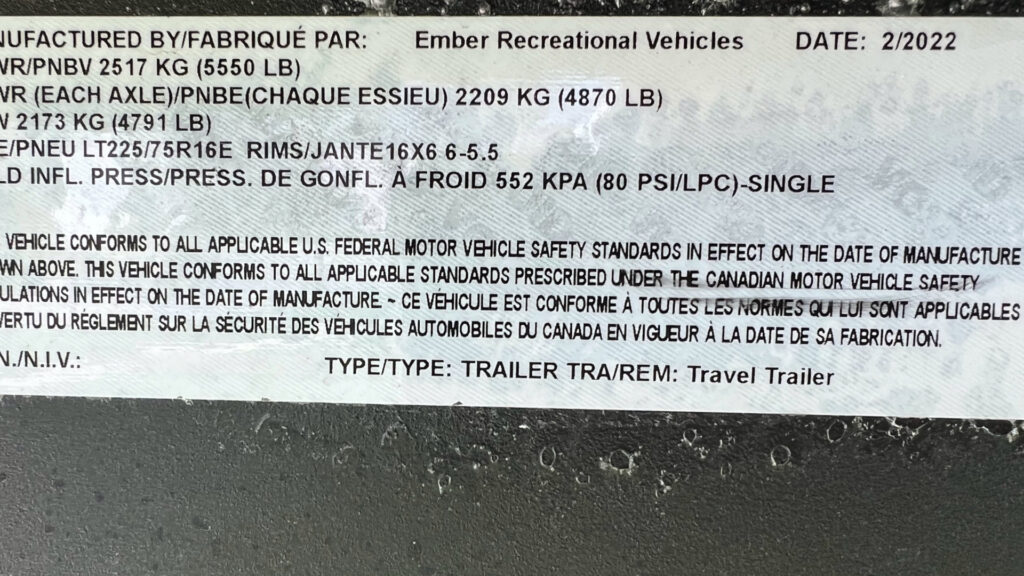
All the best in your camping endeavors!
As always, thanks to our fans who support our efforts by starting their shopping from our Amazon Storefront and by their generous financial support by using the THANKS feature located under each YouTube video ($ within the Heart icon). Your support is greatly appreciated!
